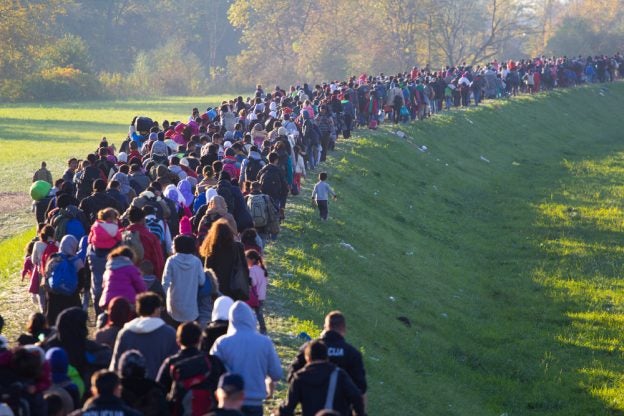Who is a refugee? A person of concern? An expellee? A stateless person? A migrant? A displaced person? The terminology is confusing at best, and perhaps deliberately so, for it obscures the acute state of dread, depravation, suffering and trauma that invariably characterizes the experiences of those who find themselves caught in the web of these labels. What is more, this terminology carries many profoundly negative connotations that undergird the suspicion, fear and hostility toward forcibly displaced people, shapes policy discussion and relief allocations, and has provided the frame to question whether or not an individual is deserving of aid.
We find ourselves at a watershed moment. We are experiencing the largest humanitarian crisis since the end of the Second World War. The global grand total of refugees and displaced people exceeds 65 million, dwarfing the earlier benchmark. Even more, this crisis is calling into question the very structures that are supposed to coordinate an international response and allocate aid. The images of human flotsam travel across our TV and computer screens with an ease that betrays the tenacity, adversity and trauma that followed the un-choice of running from certain death in the hope that one might survive the passage across the Mediterranean on inflatable rafts and then the trip from a so-called “third party country” to an ostensibly safer place in the unventilated trailer of a meatpacking truck. News coverage and public discourse in the USA and in Europe refers to them collectively as “migrants” rather than “refugees,” insinuating that their predicaments are self-inflicted, resulting from unwise decisions to tempt fate and reach for a better life. As of late, such coverage is interspersed with President Trump’s comments about not wanting people from Africa or Haiti – or, in the president’s words, from “shithole countries” – coming to the United States.
Over the past several months and weeks stigmatization of “migrants” has underpinned a lot of the “edicts by tweet” that have come out of the White House. Rhetoric about The Wall along the US-Mexican border stigmatizes an entire population as “rapists” and “drug dealers.” In November of 2017, the President has ended the protective status for Haitians, who came to the US after the devastating earthquake in 2010. The decision will affect 320,000 people from the poorest country in the western hemisphere. About 200,000 Salvadorans will be expelled by 2019; President Bush granted them asylum when a 2001 earthquake ravaged a country that had been mired in a US-sponsored civil war of a right-wing military dictatorship against marxist insurgents for over a decade in the 1980s. The recent wave of natural disasters (hurricanes and earthquakes) disrupting life and infrastructures in large parts of the Caribbean, Mexico, Puerto Rico and the Southern US did not elicit much sympathy from immigration hardliners. Instead, the Dreamers have become a bargaining tool on Capitol Hill, in the discussions over “border security” and a whole host of other issues.
None of this is sudden, none of this is without history. The crisis has been brewing for decades, with people fleeing from war, terror, oppression, persecution, famine, epidemics, environmental disasters, and destitution. The civil wars that have raged in Syria since 2011 and in South Sudan since the end of 2013 exacerbated an already precarious global situation. Rather than protecting victims of violence, the United States and many affluent countries in Europe are focused on protecting themselves from a grossly exaggerated threat to public order, national security and cultural cohesion. The responses range from mere suspicion and resentment to a tightening of regulations, extreme vetting, proposals for walls and immigration bans targeting the most destitute and casting them as the least deserving of relief. Reactions in the “West” pose fundamental questions about the future of the international human rights regime that I am not able to answer. But perhaps, as a historian of modern Europe, I can shed some light on the historical memory (or lack thereof) in Europe and the United States that may help to sketch the long-term genealogy on which comments about “shithole countries” unfortunately rest.
World War II forced questions about forcibly displaced people onto the agenda of the US and its Allies and lastingly shaped the structures of the international bodies designated to protect human rights. The United Nations Relief and Rehabilitation Administration, or UNRRA, was founded in November 1943 in anticipation of an unprecedented humanitarian crisis. In Europe, Hitler and Stalin had uprooted, expelled and deported more than 30 million people as a matter of state policy. At the end of the Second World War the number of forcibly displaced people orbited somewhere around the 40 million mark in Europe alone. Yet these numbers failed to account for populations on the move in other parts of the world, within nation states or on islands, particularly in Asia and the Pacific. The partition of India and Pakistan saw forced population movements of between 10 and 16 million people. In China, millions of people had been forcibly displaced during the war and even though accurate statistics are not available, UNRRA estimated in 1948 that more 10 million Chinese had been internally displaced and as many as 260 million people would have qualified for international relief.
The idealism that had characterized wartime planners and continued to inspire civilian relief workers quickly ran up against the harsh postwar realities. Since there were millions more people in need of aid than UNRRA could accommodate, categories and priorities shifted in accordance with what was feasible and geopolitically desirable. Envisioning relief as an international governmental responsibility rather than as the purview of private charity, the Allies defined displaced persons (DPs) as “civilians outside the national boundaries of their country by reason of the war” (Cohen, 440). Accordingly, internally displaced persons were not eligible for aid, a distinction that was retained in the definition of “refugee” put forth by the 1948 declaration of Human Rights. As G. Daniel Cohen has illustrated, this American-led and financed internationalism “not only played a landmark role in the birth of the UN system, but also shaped the new world organization into a prominent humanitarian actor” (439). With offices in Asia, the Middle East, and Central Europe, the brunt of the agency’s efforts were directed at the DPs in Germany, who had been transported to Germany by the Nazi regime as prisoners of war and forced laborers. In addition to the more than 11 million foreign victims of the Nazi camp and slave-labor economies, millions of expellees, ethnic Germans from Soviet Russia and Eastern European countries, flooded into Germany as the Red Army advanced westward.
From the very beginning, the UNRRA and its successor organization, the office of the United Nations High Commissioner for Refugees (UNHCR) established in 1950, had to devise strategies to separate individuals deemed worthy of aid. The wretched and often emaciated individuals hardly elicited responses of unqualified humanitarian compassion. The case of the 20,000 Jews who survived Nazi persecution is instructive here. Initially, they found themselves in the very same facilities from which they had just been liberated, often side by side with many of their former tormentors and guards who also had escaped occupied Germany. They were treated with scorn, as illustrated by US Army General George Patton’s comments, “let it be known that the ‘Jewish type of DP is in the majority of cases a sub-human species’, ‘lower than animals’” (Cohen, 447). Only upon President Truman’s insistence were the Jewish DPs recognized as unique victims of Nazi racial persecution and cared for in separate facilities. The respective worthiness of the remaining DPs often depended on their willingness to return to their country of origin. At least initially, Western Allies did not shy away from forcibly returning DPs as was the case with 2 million Soviet citizens, many of whom were received as traitors and subjected to brutal and often deadly actions of reprisal. Only the hardening of Cold War political fronts in 1947 saw an end to forced repatriation and a recognition of Soviet nationals as political refugees (Judt, 31).
Accordingly, the administration of relief, the repatriation of displaced people and the care of refugees was not only a humanitarian problem but also a military one. Civilian organizations such as UNRRA were under the jurisdiction of the Supreme Headquarters Allied Expeditionary Force (SHAEF) and the screening and control of the uprooted and destitute populations was enforced through military discipline and techniques (Malkki, 498). Housed predominantly in camps – often former Nazi concentration and prison camps – refugees were subjected to rehabilitation practices inspired by a paternalistic humanitarianism focused on self-government, democratization and education, and to a harsh discipline that was aimed to contain and neutralize refugees as potential vectors of disease, crime and disorder.
The international system that developed to guarantee and protect human rights also institutionalized the suspicion and distrust of refugees, making aid and relief contingent on their continued submission to containment, discipline and control. The emergence of the “Third World,” the struggle for decolonization and independence, and the proxy wars between the Cold War superpowers contributed to the increasing racialization of the “refugee” label and turned it into a shorthand for poor people of color from the “Global South.” Unlike the DPs in postwar Europe, today’s refugees find themselves confined in permanent camps, with constrained parameters of movement, insufficient medical and sanitary provisions, no opportunity for full personhood and no future. Those who think they have made it to safety find themselves confronting stigmatizing, derogatory and demeaning language, discrimination and police violence, and increasing threats of deportation. More than 65 million people – half of whom are children – not only suffer the trauma of war and displacement but they too find themselves caught in the same web of confusing labels and constant dehumanization and denigration.
References:
Cohen, G. Daniel. “Between Relief and Politics: Refugee Humanitarianism in Occupied Germany, 1945-1946.” Journal of Contemporary History, 43, no. 3 (July 2008): 437-449.
Judt, Tony. Postwar: A History of Europe Since 1945 (New York: Penguin, 2005).
Malkki, Liisa. “Refugees and Exile: From “Refugee Studies to the National Order of Things.” Annual Review of Anthropology 24 (1995): 495-523.
Shepard, Ben. “‘Becoming Planning Minded’: The Theory and Practice of Relief 1940-1945.” Journal of Contemporary History 43, no. 3 (Jul 2008): 405-419.
“UNRRA in China, 1945-1947.” Operational Analysis Papers, No. 53. United Nations Relief and Rehabilitation Administration (Washington DC: April 1948).
—
Anne Berg received her PhD from the University of Michigan in 2011. Trained as a historian of modern Germany and Europe, she continues to research and teach in these fields but she is increasingly venturing into more global terrain. She studies cities, war, public leisure, film, popular culture, and is most deeply interested in the global politics of waste and recycling.


